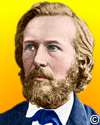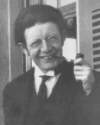
On 9 Aug 1919, Ernst Haeckel died, the German naturalist and biologist who separated the animal kingdom into unicellar and multicellular organisms, and was an enthusiastic supporter of Darwin's theories.
Not all of Haeckel’s published ideas were correct. His article Evolution, from The Library Of Original Sources (1907), must be read with care. Consider it as merely a faulty stepping-stone in the history of biology. Haeckel—as we now know—was in error when he popularized the expression, “Ontogeny recapitulates phylogeny,” meaning that he supposed any animal embryo progresses through all previous evolutionary stages as it develops. Yet as you read, you can appreciate how science is self-correcting, and recognise that one theory leads to another, better one, that replaces it in modern times. Haeckel's understanding may have been mistaken, but he nevertheless brought attention to the subject, and thus contributed to the progress of the discipline. So, read this Haekel’s document on Evolution like opening a time-capsule from the 19th century.

On 9 Aug 1898, Gardner Quincy Colton died. He was an American lecturer who was the first to administer nitrous oxide as an anaesthetic. He gave scientific lectures. Initially, nitrous oxide (laughing gas) was exhibited by Colton as a novelty demonstrating its mirth-provoking effects. Its value as a dental anaesthetic was recognized by Dr. Horace Wells, who adopted its use in his dental practice, though its use did not spread at that time. Eventually, it was Colton, though not a dentist himself, who popularized its use in dentistry to replace the more risky method of using chloroform and ether. Acceptance in the profession was slow, but eventual Colton gained fame from his efforts. An article on Gardner Quincy Colton and Nitrous Oxide Anaesthesia from History of New York City (1884) focusses on this aspect of his life. Yet Colton was known also for more diverse interests. He exhibited a model railway in 1847, using a metallic track in the circuit to supply electricity to the locomotive’s motor. He was also a Shakespearean scholar.

The son of a shepherd, Thomas Telford was born in Westerkirk, Scotland on 9 Aug 1757. At the age of 14, he was apprenticed to a stonemason. He worked for a time in Edinburgh and in 1782 he moved to London. By this time, Telford had established a good reputation as an engineer and in 1790 was given the task of building a bridge over the River Severn at Montford. This was followed by a canal that linked the ironworks and collieries of Wrexham with Chester and Shrewsbury. On the Pontcysyllte Aqueduct, Telford used a new method of construction consisting of troughs made from cast-iron plates and fixed in masonry. With the success of these structures, Telford began his rise to fame that eventually made him one of the greatest engineers in Victorian Britain. His bridges, aqueducts, roads, and canals combined aesthetic grace with brilliant engineering, and perhaps no other single individual contributed more to making Britain the “workshop of the world.” Today's book pick is: Thomas Telford, by T. C. Rolt. The author is an experienced writer of biographies on several great British engineers, including Brunel and the Stephensons, as well as Narrow Boat.
It is available from Amazon, typically about New from $17.04. Used from $4.94. (As of earlier time of writing - subject to change.)
 | You don't understand anything until you learn it more than one way. |
 | Chance... in the accommodation peculiar to sensorimotor intelligence, plays the same role as in scientific discovery. It is only useful to the genius and its revelations remain meaningless to the unskilled. |
 | Ohne Phosphor, Kein Gedanke. Without phosphorus there would be no thought. |
| Before you look at today's web page, see if you can answer some of these questions about the events that happened on this day. Some of the names are very familiar. Others will likely stump you. Tickle your curiosity with these questions, then check your answers on today's web page. | |
| Births | |
 | Jean Piaget, born 9 Aug 1896, was a famous child psychologist and zoologist. By age 15 he was contributing articles on molluscs to journals of zoology, and his doctoral degree (1918) thesis was on the distribution of molluscs in the Valaisian Alps. Thereafter, he turned to researching how mental growth develops in several successive stages from infancy to adulthood - “the embryology of intelligence” - for which he became distinguished. What was his nationality? |
 | An Italian chemist and physicist. born 9 Aug 1776, is very well known for his Law that states that under conditions of constant pressure and temperature, there is a direct relationship between the volume and number of moles for an ideal gas. (6.022 x 1023 units per mole of a substance.) Can you name this scientist? |
| Deaths | |
 | An English chemist (1825-1899) was one of the first investigators in the field of structural chemistry, invented the chemical bond, and became known as the father of valency. He studied organometallic compounds - hybrid molecules of the familiar organic non-metallic elements (such as carbon, hydrogen, nitrogen, sulphur, phosphorus) with true metals. By 1850, he had prepared small organic molecules containing such metals as zinc. Subsequently, he devised the theory of valence (announced 10 May 1852), that each type of atom has a fixed capacity for combination with other atoms. For his investigations on water purification and for his services to the government as water analyst, he was knighted in 1897. Can you name this chemist? |
 | John Warne Gates was an American inventor and promoter, known as John “Bet A Million” Gates, because he was also a speculator. He discovered a market for a wire product widely used in the development of the Western plains. He began its manufacture in St. Louis, Missouri, and became wealthy. What was the product that made Gates successful? |
| Events | |
 | On 9 Aug 1956, the first statewide, state-supported educational television network went on the air in U.S. In which state? |
 | On 9 Aug 1945, during WW II, a second atomic bomb was dropped on another Japanese city, by the Americans. What was this second city to be hit with an A-bomb? |
Fast answers for the previous newsletter for August 8: black holes • cyclotron • jet aircraft engine • mimeograph - stencil duplicator • the decade including the year 1829.
 If you enjoy this newsletter, the website, or wish to offer encouragement or ideas, please send feedback by using your mail reader Reply button.
If you enjoy this newsletter, the website, or wish to offer encouragement or ideas, please send feedback by using your mail reader Reply button. Your click on a Facebook, StumbleUpon, or other social button on the site webpages is also a welcome sign of appreciation. Thank you for using them.
© This newsletter is copyright 2020 by todayinsci.com. Please respect the Webmaster's wishes and do not put copies online of the Newsletter — or any Today in Science History webpage. (If you already have done so, please remove them. Thank you.) Offline use in education is encouraged such as a printout on a bulletin board, or projected for classroom viewing. Online, descriptive links to our pages are welcomed, as these will provide a reader with the most recent revisions, additions and/or corrections of a webpage. For any other copyright questions, please contact the Webmaster by using your mail reader Reply button.
--
If you do not want to receive any more newsletters, Unsubscribe
To update your preferences and to unsubscribe visit this link
Executive Real Estate Business Class
-
"It was like a man with wings. It wasn't like anything you'd see on TV or in a monster movie." ...
About the publisher
Search This Blog
Blog Archive
-
▼
2021
(585)
-
▼
August
(32)
- Newsletter for Tuesday 31 August.
- Newsletter for Monday 30 August.
- Newsletter for Sunday 29 August.
- Newsletter for Saturday 28 August.
- Newsletter for Friday 27 August.
- Newsletter for Thursday 26 August.
- Newsletter for Wednesday 25 August.
- Newsletter for Tuesday 24 August.
- Newsletter for Monday 23 August.
- All-New Tonight: 'The Machines That Built America'
- Newsletter for Sunday 22 August.
- Newsletter for Saturday 21 August.
- Newsletter for Friday 20 August.
- Newsletter for Thursday 19 August.
- Newsletter for Wednesday 18 August.
- Newsletter for Tuesday 17 August.
- Newsletter for Monday 16 August.
- Newsletter for Sunday 15 August.
- Newsletter for Saturday 14 August.
- Newsletter for Friday 13 August.
- Newsletter for Wednesday 11 August.
- Newsletter for Tuesday 10 August.
- Newsletter for Monday 9 August.
- All-New Tonight 9/8c: Telephone Wars
- Newsletter for Sunday 8 August.
- Newsletter for Saturday 7 August.
- Newsletter for Friday 6 August.
- Newsletter for Thursday 5 August.
- Newsletter for Wednesday 4 August.
- Newsletter for Tuesday 3 August.
- Newsletter for Monday 2 August.
- Newsletter for Sunday 1 August.
-
▼
August
(32)
-
Blogroll
-
About
HistoryFact










0 comments:
Post a Comment